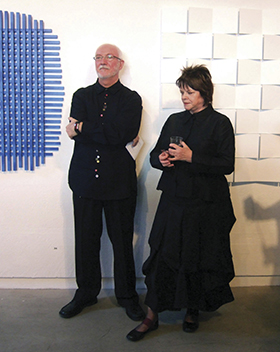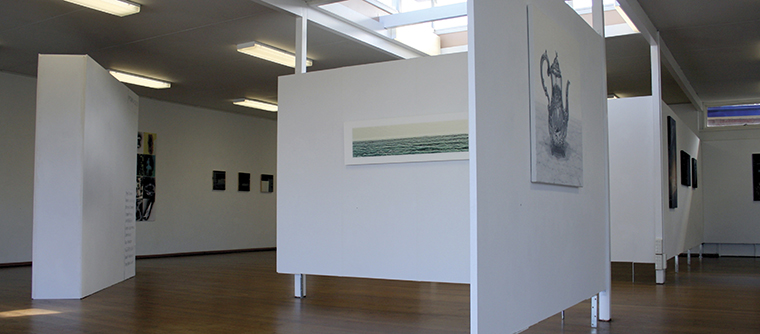 Navigating a Changing Sector
Navigating a Changing Sector
Words by Nyanda Smith
December 2012
As widely reported, movement is currently afoot within Perth’s commercial gallery sector, with a number of galleries central to the arts arena over the last four decades closing (Gallery East, Perth Galleries and Galerie Düsseldorf) taking a break (Goddard de Fiddes) or considering a restructure (Indigenart – the Mossenson Gallery). Reasoning for the change is given as a blend of retirement, personal circumstance and economics – a flat market both locally and nationally. As the dust settles around the announcements, what are the affected artists thinking about it all, both practically and symbolically? What did representation provide them, and what are they now looking towards?
After two decades without a commercial gallery in New York City, signing with Perth Galleries “boosted my confidence” explains Chris Hopewell. “It enabled me to start exhibiting, and provided networking potential. Gaining that exposure and critical feedback has been significant.” Newly unrepresented, Chris remains confident that he’ll be able to achieve his objectives without a gallery. “I’ll miss the gallery doing the footwork, but I don’t feel it will be such a huge impact as I’ve been steadily working throughout my career, and managed to sell work and place it into collections without one.”
Merrick Belyea, represented by Gallery East for 12 years, describes his experience as providing a consistent breadth of exposure crucial to his career. “It’s allowed me to be seen as a practicing artist with a strong exhibition history.” He cites the ability for national promotion, in particular within the commercial marketplace of the Melbourne Art Fair as a key benefit, something notoriously difficult for artists this side of the Nullarbor.
He considers the current situation to be critical. “To me the commercial art scene in Perth is in a state of turmoil, I don’t think it’s just changing of the guard. You can’t say the closure of four or five major galleries is just bad timing. I think that there is less income for galleries and for artists, less opportunities for audiences to see work on a regular basis, and less chance for that longevity of career and relationship, and that’s a crisis.”
Being awarded the Galerie Düsseldorf Postgraduate Scholarship upon graduating from Masters at Curtin University eight years ago provided Susanna Castleden an “amazing ticket”, in allowing her a smooth transition from student to professional artist. “Doug and Magda were able to present my work to a much broader and wider audience, than I would ever have imagined. Initially it was access to this beautiful space, to be seen among that calibre of artists and exposure – having your work suddenly in various collections.” She explains that her main reaction to the news of the closure is one of indebtedness. “Doug and Magda have done it so well for so long, I really respect their decision to finish. They have put in the hard yards, supporting a lot of young artists, and so I am not sad in that sense.”
Having enjoyed a long “mutually satisfying” thirty-four years with Galerie Düsseldorf, Brian McKay proposes that movement in the sector may be the symptom of deeper, fundamental changes. “I’m not surprised that things are changing, having witnessed attitudinal shifts in the visual arts over the years. I think that perhaps galleries have to change, as art itself has changed with the emergence of digital media and to the resulting decline in interest, of a two dimensional object called a painting,” he counters.
So, what’s next? Joining the majority of unrepresented Western Australian artists, they will need to find new opportunities to maintain their profile, show and sell their work.

Merrick won’t be immediately seeking another gallery. “I’ll probably go back to the beginning in a way, and start showing at artist run spaces and art centres, while, as always, looking nationally and internationally for opportunities. That has never stopped and never will. But without a commercial gallery, I will have to be more proactive in how I get the information out there than I’ve had to be for the last 12 years. Visibility suffers when you are not regularly exhibiting.”
Currently undertaking work that “…possibly wouldn’t sit comfortably in the commercial gallery space”, Susanna explains that, “…right at this minute it’s not on my radar, but certainly if I wasn’t in this position, I’d be having to think about it. It really depends on where individual artists are in their life cycle.”
Chris and his wife, artist Carol Wells, are building a studio-gallery to show their work in once-a-year openings. “I’ve already heard of co-operatives of artists getting together and holding weekend exhibitions. I think there will be a lot more of that,” says Chris. This model allows more autonomy and commission for the artist, but requires them to take on the multilayered roles of exhibiting, promoting, and selling their work. Chris isn’t concerned about tackling these tasks, feeling he’s at a point in his career that he understands the placement of his work within the market.
“I’m not a businesswoman and that’s what the gallery did brilliantly, and I don’t know how I’ll replicate that as yet,” says Susanna.
“I have enjoyed the buffer of the gallery,” explains Merrick. “It’s a nice way of not putting pressure on the artist to be promoting ourselves all of the time. I feel that with the closure of the galleries we will lose one arm of that promotional machine and it puts the pressure on us to sell ourselves more. With every aim to do that with integrity and honesty.”
Another role of the commercial galleries has been to cultivate relationships with a collector base, and concern is raised about the loss of the educative cultural role the galleries have provided. “You aren’t born with the collecting bug, the galleries have been a great venue to build that relationship with collectors over long periods of time,” says Merrick.
Chris raises a similar concern. “I see that as the only big downside, that without the focused institutions where the public and buyers can go to, there will be a lot smaller exposure for the community at large. People who are not in the know might decide to go and look at two or three galleries on the weekend, and may not be able to find the guerrilla exhibition out on the fringe.”
Will this enforced period of change provide a chance for the commercial gallery sector to grow and evolve? There is much discussion about a number of emerging galleries, artist run initiatives (ARIs)* and pop-up programs gaining momentum, of which tangible excitement exists. However, are they enough to replace the ongoing supportive role the galleries have held?
Helen Turner, owner of Turner Galleries, suggests the changes offer an opportunity for new approaches. “Nobody likes the vanguard to move on, we all feel a little bit abandoned, or lacking in that seniority and guidance. But I feel that it’s a period where there is an opportunity for things to change, or become better, or more expansive,” she says.
“It occurs to me that the traditional gallery and artist relationship is one way but it’s not the only way, and that the options available now to artists in terms of running their own practice both collectively and individually, offer an opportunity for new models that perhaps involve the community more in what we do. I think this is an opportunity for artists to stand back and look at what they do, to think laterally about options, and most importantly focus on their work.”
“Having said that, I think there will be other galleries that open because there is a gap, and that is the model that we are used to. Maybe it’s time for some of the new upcoming spaces to step up a bit more and take on board some of the more senior artists, exhibiting them alongside the younger people. There are lots of options and, as there is a gap, interesting things will happen.”
Some of the successful new galleries blend elements of commercial and traditionally non-commercial realms. Artist Ron Nyisztor established Nyisztor Studio in 2006 as an independent ARI. The gallery parallels a commercial model with its stable of ‘associated artists’ and by curating a regular exhibition program on a proposal basis, but differs in its democratised ethos, operating as a collective. It places promotional exposure as a key focus, building relationships with other galleries or spaces, and holding exhibitions interstate and overseas.
Melody Smith Gallery has evolved rapidly since opening two years ago, initially to provide studio and exhibition opportunities for artists. Owner Melody Smith describes how today she hopes to, “…add to the diversity and interest of the typical commercial gallery model with a dedicated project space and a willingness to collaborate with artists, curators, writers and other organisations. This approach is commonplace in a national and international context but has not historically been usual practice locally.” She details how the gallery’s, “…open and outward programming includes the presenting of externally curated exhibitions from artists that are not represented by the gallery, but where interesting relationships and links exist.”
Watch this space.
Nyanda Smith has written about the visual arts for a number of publications including Artlink, The West Australian, Realtime, Australian Art Collector, and presented a visual arts radio segment on ABC 720. She is an editor at Lethologica Press, a small press publishing intriguing combinations of text and art.
This article featured in the Artsource Newsletter, Summer 2012/13.